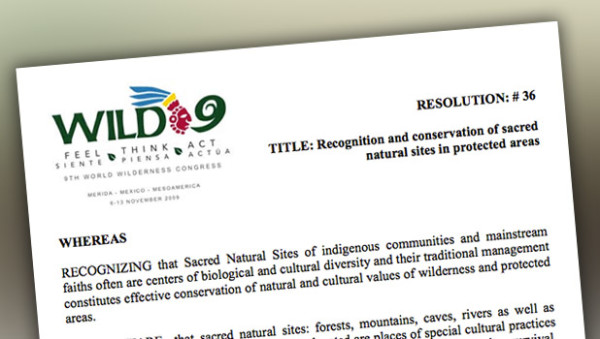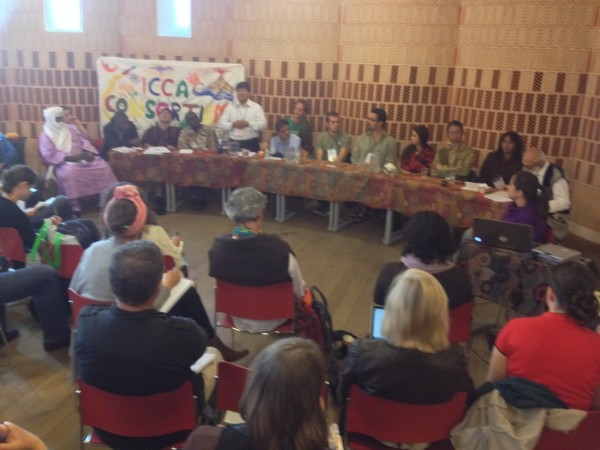
The 10ht World Wilderness Congress has seen significant discussions about many issues related to Sacred Natural Sites and Indigenous communities. Sacred Dabas Sites iniciatīva iesniegta par to, cik svarīgi ir Sacred Dabas Sites in saglabāšanas stratēģiju par garīgo ainavu, kā arī globālajos tīklos, par kalnu takām. Viens no SNSI s konsultantu, Mayan Spiritual Leader and coordinator for Oxlajuj Ajpop Mr. Felipe Gomez, delivered presentations and participated in the Indigenous Land and Sea Forum. At the form several important issues were explored of which two stood out. The first issue focused on how to halt irresponsible extractive industries that put the world’s sacred natural sites, protected areas and world heritage sites at risk whilst the second issue explored the concept of Wilderness seen from on a range of different worldviews.

Previously at WILD 9 this resolution on Sacred Natural Sites in Protected Areas was adopted in 2009 (redzēt bibliotēku). This year two additional resolutions were proposed at WILD 10 (follow the links in this news article).
Wilderness conservation clearly intersects with the protection and revitalisation of Sacred Natural Sites and the threats posed to them by extractive industries. As part of a broader group lead by Gaia Foundation and TILCEPA the Sacred Natural Sites Initiative supported the development of two resolutions. Both resolutions are open for you to comment and “sign on”. The first resolution dealt directly with the establishment of NO-GO zones for extractive industries over sacred natural sites. It found support with protected Areas and World Heritage sites that are also experiencing an intrusion by extractive industries, especially mining.
The second resolution calls for the recognition of Sacred Natural Sites and Territories as a distinct category of Protected Area, respecting that there is a plurality of Sacred Natural Sites’ systems that should be recognised each on their own terms as expressed by their custodian communities; and that this category should be recognised in international fora (such as those convened by the IUCN) and in legal instruments and policies, particularly the Convention on Biological Diversity. With several key resolutions already adopted at WILD9 in 2009 and the World Conservation Congresses in 2008 un 2012, these WILD10 resolutions are expected to add weight to pressing issues awaiting recognition with the international community.
In addition to the work on Sacred Natural Sites, a session accommodated by the Indigenous and Community Conserved Areas Consortium over eight indigenous representatives of different ethnicities – TLA-o-qui-aht, Maya K’iche, Arutam, Batwa Walikale, Yuareg, Pongso no Tao amongst others – gave their views on the true meaning of Wilderness. The examples given showed the richness of worldviews complementing if not overwhelming the mainstream conservationists’ view on wilderness.

The participants to the Indigenous Land and Sea Forum at Wild 10 discuss the meaning of Wilderness in thier worldviews as well as the importance of proetcted Sacred Natural Sites from extractive industries and other uncontrolled developments. Avots: B. Verschuuren 2013.
Kad Tla-o-qui-aht people in Canada were asked for a word for wilderness in their language, they retreated for four days and finally decided on the word “home” Felipe Gomez from Oxlajuj Ajpop [www.oxlajujajpop.org.gt] stressed that wilderness is part of our mother earth that we are all born of. In the Maya K’iche spirituality the earth requires listening to, talking to and caring for its sacred sites in accordance with the Maya calendar. All examples showed a relationship of reciprocity to the earth, nature and territory. The diverse testimonies on wilderness base don indigenous worldviews showed that the exclusionary protectionist view of wild lands void of people have no place in the conservation of our common world. Such a legacy is hard to overcome or improve upon but the tide is finally turning.
Stan Stevens, treasurer of the ICCA Consortium suggested that Wilderness conservation would probably have looked a lot different if its early founders such as Aldo Leopold and John Muir would have learned more form the indigenous peoples’ leaders of their time. Vance Martin, director of Wild Foundation recognized the importance of these worldviews in terms of representing a diversity of solutions for conservation. He envisioned that it should be possible to follow these indigenous relationships with the earth and seek a unifying force of love for wilderness and mother earth that through evolution has been encoded in our genes.






